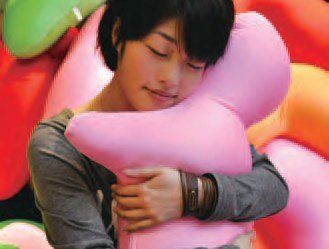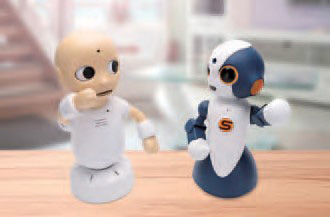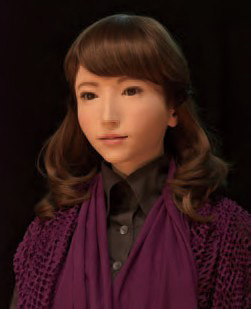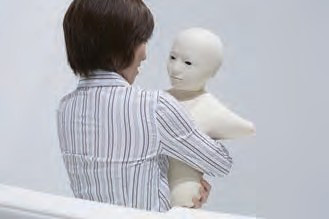Research Results
Relationship Newly Developed Between Humans and Robots
Robot Technology for Improving Human-Robot Interaction FY2016

- Hiroshi Ishiguro (Professor, Department of Systems Science, Graduate School of Engineering Science, Osaka University / Visiting director and ATR fellow, Intelligent Robotics and Communication Laboratories of Advanced Telecommunications Research Institute International (ATR))
- CREST
- Studies on cellphone-type teleoperated androids transmitting human presence
"Creation of Human-Harmonized Information Technology for Convivial Society" Research Director (2010-2014) - ERATO
- "ISHIGURO Symbiotic Human Robot Interaction Project" Research Director (2014-2019)
"Hugvie"enables users to strongly feel the presence of remote partner on a call
The lady is holding a human-shaped beaded cushion similar to the body pillow with happy face. She puts her ear on the head of the human-shaped pillow so she can hear the voice of the interaction partner in a distant location, and the partner hears the user talking. Now you know that the cushion is a human-shaped pillow phone. Hugvie is a new communication media that, when holding it, can create a strong feeling as if the phone conversation partner in a distant location were beside the user, a feeling that cannot be attained via ordinary phones.

Stress relieving effect by experiencing partner's presence while on a call
Hugvie was originally developed by Prof. Hiroshi Ishiguro. He has been working on the development of humanlike robots capable of successfully interacting with humans, including the humanlike androids not only in their appearance but also in their delicate movement and humanoids such as Robovie designed for natural communication with humans.
One of his study themes is creating Geminoid (a portable teleoperated android robot) that enables users to show their presence even though they are in a distant location. When a geminoid, which is created resembling the user, interacted with others by remote operation from a distance, it was confirmed that these people felt as if a familiar face were there and could have a natural conversation with the creature.
As a result of further study, the necessary features were carefully selected to simplify the functions. The research showed that user could effectively feel the presence of the interaction partner when hugging or holding a simple object without humanlike fine movement or appearance while speaking to the partner. Hugvie was developed based on this finding. It has a pocket in its head so the user can place the communication device, such as a mobile phone, inside. The user who hugs it while on a call can strongly sense the presence of the interaction partner by the simplest elements including the partner's voice close to the ear and vibrations in synchronization with the voice tone of the partner. According to the effect evaluation, the group who hugged the Hugvie during the conversation had lower levels of hormone cortisol in their blood, which is elevated with stress, compared to the other group who had a conversation using an ordinary cell phone. The result showed that Hugvie was effective in relieving stress similar to what one might find in physical contact with another person.
The results obtained through the research provide new insight into the future design of communication media. The communication media, such as Hugvie, for talking in a hugging state can be effective for remote therapy by phone.
Social Conversation Robot CommU and Sota
The tabletop robot with big round eyes is talking to a fellow robot. I have joined their conversation as the robot talked to me. This could be quite weird. The name of this creation is CommU, which was inspired through the research for developing robots designed to naturally interact with people. This creature is the work of Prof. Ishiguro known from ERATO Ishiguro Symbiotic Human Robot Interaction Project and Associate Prof. Yuichiro Yoshikawa from the Graduate School of Engineering Science, Osaka University, in collaboration with a robot company Vstone.
CommU is about 30 cm in size, consisting of only the upper body. The robot draws humans into conversation between other robots, thereby the participant feels the sense of conversation that had been difficult to acquire. CommU is capable of demonstrating natural conversation by a natural facial expression and eye movement because of the plentiful degrees of freedom in its eyes, head, and body, which are not usually adopted to a small robot.
Sota is a robot inspired from the research results of CommU and developed by Vstone for the purpose of commercial products. It has a simple architecture whose eyes do not move and the limited degrees of freedom in physical movement. This creature was designed by a robot creator Tomotaka Takahashi.

Social Conversation Robot CommU on left and Sota on right

Toward the successful relationship between human and robot
The project group is now making effort to exemplify the effectiveness of androids in therapy for elderly people or children with autism, as well as for the communication study and learning support, using Erica, which was designed for natural conversation by the newly developed voice recognizer, and the baby sized android, Telenoid, which was developed by CREST. How will those robots be further developed and transformed into advanced unique creatures from now on? Are they able to provide the new insight on the future relationship between humans and robots?

Android Erica

Telenoid
